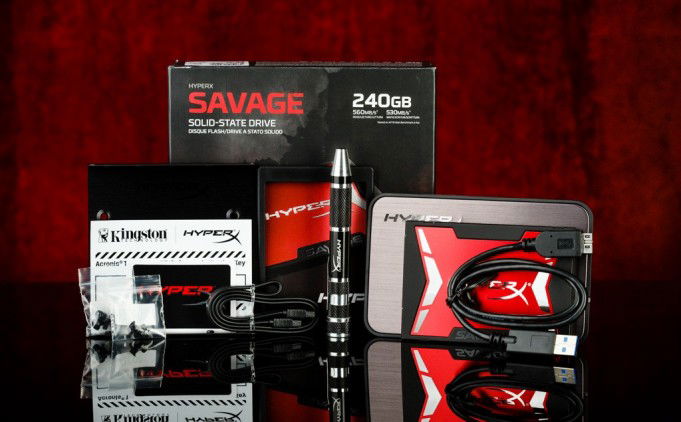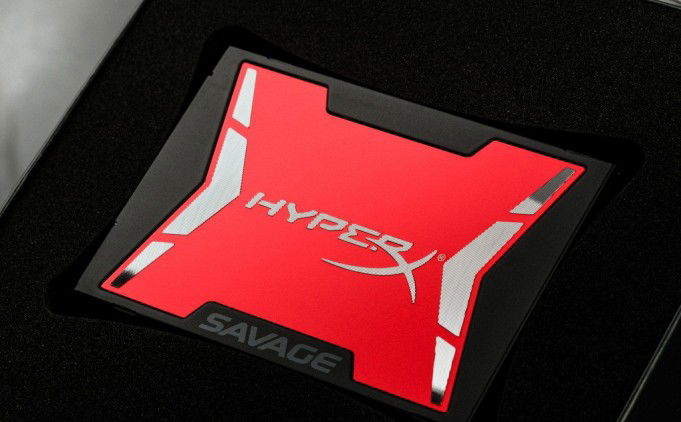Manufacturer: Hyper X
Pricing: RRP $100 (NewEgg/Amazon – United States Region) / RRP $150 (Online Average – Australian Region Pricing)
Available from: Computer Parts Stores (See Kingston Where To Buy Page for full list)
Disclosure: The Hyper X Savage 240Gb SSD was provided by Gap Marketing on behalf of Kingston/Hyper X.
I was warned about this. Other tech head people I know told me that once I got my hands on a Solid State Drive that I’d never want to go back to using standard mechanical drives. I also should have known something like this would happen when I used the Solid State Hybrid Drive that I fell in love with in my last review.
Those people were right, once you see the speed of a SSD, you see everything else as slower than a snail going uphill against the wind. I should also have known that with the Hyper X branding on this drive that I was in for something that was going to blow my expectations out of the water. Thus began my time with the Hyper X Savage SSD.
As usual, here are some techy words to make you feel like you know something:
Form factor: 2.5″
Interface: SATA Rev. 3.0 (6Gb/s) – with backwards compatibility to SATA Rev. 2.0 (3Gb/s)
Controller: Phison PS3110-S10
Power Consumption: 0.39W Idle / 0.5W Avg / 1.4W (MAX) Read / 4.35W (MAX) Write
Storage temperature: -40°C~85°C
Operating temperature: 0°C~70°C
Dimensions: 100.0mm x 69.9mm x 7.0mm

Test 1: USB3.0 External Drive
I was only able to conduct this test because unlike a lot of other hard drive manufacturers, Hyper X loves to give you a whole bunch of extras so that what you buy can be used for every situation. In this case, you get a nice shiny external hard drive enclosure that allows you to turn it from a standard internal drive into an external portable drive.
It was really quite easy to do. You just plug the Hyper X Savage into the case, close thing case up and it’s ready to go. It’s powered by the USB3.0 cable that comes with the case and once the driver has installed and you have initialized the disc itself through the disc management system (Though this could just be me using Windows 7 or having the first review model) it’s ready to go.
The speed at which the Hyper X Savage copies is amazing. Unlike most places that use benchmark programs to do it all in a flash, I use the files on my computer in the following amounts: 1.5Gb, 5Gb & 10Gb. With all of these files I noticed the speed would be either 90mb/s with a maximum speed of 250mb/s. This translates into a 1.5Gb file transferring in 5 seconds, 5Gb in 60 seconds, and 10Gb in 1.5 minutes. To be completely honest, this is about the same times that the SSHD I tested a few weeks ago did, which is weird since the speeds were faster than the SSHD. I’m going to put this down to it using USB instead of direct SATA.
Test 2: Storage Drive
Second test is basically removing one of the drives from my computer and replacing it with the Hyper X Savage SSD. This also gave me a chance to use the packed in 3.5” mounting bracket. For those who don’t understand that last bit, the Hyper X Savage SSD itself is a 2.5” drive, usually seen in laptops and gaming consoles. 3.5” drives are the brick looking ones you’ll find in most desktop computers. The brackets in most desktop computers are made for 3.5” drives, so a 2.5” drive won’t sit in those slots properly. Hyper X gives you a few extra pieces of metal to help fit the Hyper X Savage into the slots. Again, Hyper X gives you everything you’ll ever need for any situation.
As for the actual testing, it was the same thing I did last time. I copied World of Warcraft onto the Hyper X Savage and timed the copy with a stopwatch. The time came in at 1 minute 5 seconds for 60Gb of data with a 300mb/s top transfer speed. This is amazing speed and times, showing the true power of the Hyper X Savage SSD.
From here I booted the game. On a mechanical drive the boot time is 25 seconds from pressing the “Play“ button to actually loading the game. With a SSHD it was 2 seconds. Guess what? With the Hyper X Savage SSD: Instant loading! Click Game Done! This is amazing. I also loaded the Hyper X Savage up to 80% capacity and tried again… No slow down at all. Click Game Done! So of course I know what needs to be done next.
Test 3: Main OS Drive
If this test taught me anything it’s that you need to do a bit of fiddling to get Windows 7 to work with a SSD. I was lucky enough that because I’ve done most of the configurations with it as the Storage drive, but I recommend people look up some guides via Google if your system won’t recognize the drive right away.
Once things got installed, I put the usual suspects back onto the system so I could continue working as usual. So World of Warcraft, Skype, Office, Ventrillo, Team Speak, etc. By the time I had everything installed the drive was very full, showing the limitation of having only 200Gb available after formatting and installing Windows 7.
Doing a cold boot into Windows with the Hyper X Savage clocked in at 20 seconds, shaving 10 seconds off the SSHD boot time. This might not seem like much, but to someone who wants to get into things ASAP, this is a great thing.
At the end of the day, using a SSD like the Hyper X Savage is an amazing thing. The speeds in which it operates are something I never thought I would see in computers, it’s seriously like something out of a Sci-Fi movie. However, the only issue I have with the Hyper X Savage is that the size of the drive I was provided with is way too small for my personal needs. If you can lower or prioritize how many programs you need on your main OS drive then the 240Gb is fine, though it’s optimal with laptops in my opinion. Hyper X does have other sized drives available in its Savage line with a 960Gb being it’s highest capacity; though you will be paying a premium price of easily USD$500/AUD$700 for it.
Summary
While the Hyper X Savage is a BEAST of a Solid State Drive, I find it hard to recommend any SSD at this point in time. The technology is still too new and pricey for most common PC users. However Gamers will love the speed it delivers. The biggest disappointment is the size. 240Gb is not enough room for most computer users who don’t use their machines for dedicated things, and the 960Gb is too expensive to use.
Once the price of SSD’s come down to something affordable for all, then I recommend grabbing the Hyper X Savage series. It’s by and large the best drive out there on the market and will work perfectly with AMD and other Kingston products *hint hint*


